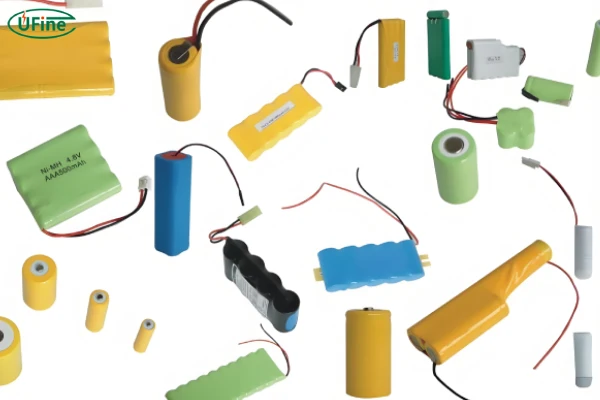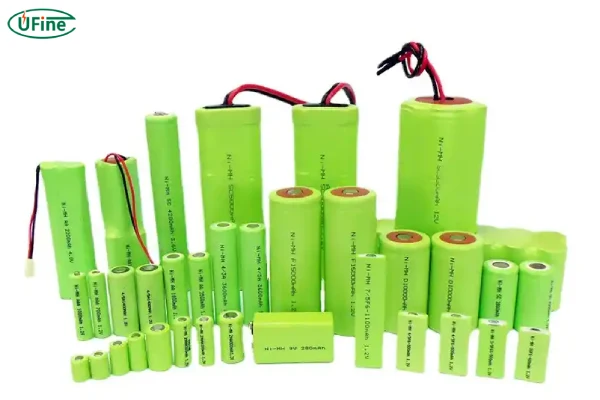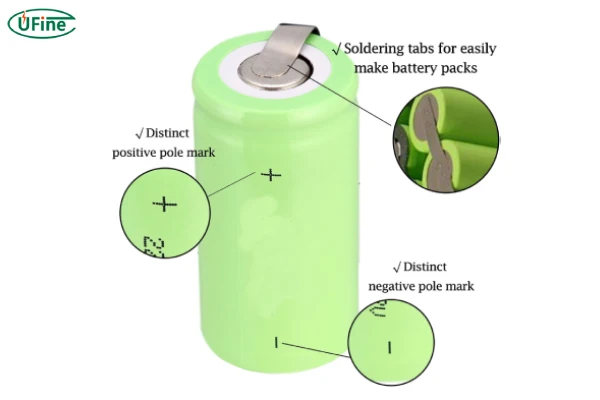NiMH battery packs are increasingly popular across a range of devices, from toys and electronics to heavy-duty tools. Unlike traditional disposable batteries, NiMH packs can be recharged and used repeatedly, making them a more eco-friendly and cost-effective option in the long run. But what exactly goes into a NiMH battery pack, and how do you know if it’s the right choice for your needs? This guide will explore every aspect of these battery packs—how they’re built, how they perform, their common configurations, and more—to help you make an informed decision. By the end, you’ll be fully equipped to decide whether a NiMH battery pack is the best fit for your power needs.
Part 1. Composition of a NiMH battery pack
NiMH battery packs are essentially collections of individual nickel-metal hydride (NiMH) cells wired together to deliver higher voltages or greater capacities than a single cell could provide on its own. But each component in a NiMH pack has its own purpose and importance:
-
NiMH Cells: The cells are the heart of the pack, each typically offering a voltage of 1.2V. These cells hold energy through a reaction involving nickel oxide hydroxide and hydrogen, providing a stable and reliable power source. When several of these cells are combined, they produce the total voltage and capacity that powers your devices.
-
Casing and Insulation: The cells are usually encased in a protective shell made from sturdy materials like plastic or metal. This casing not only protects the cells but also provides a barrier against external impacts and potential leaks. Inside, the pack may include insulating materials to separate the cells, reducing the risk of short circuits.
-
Connectors and Wiring: Inside the pack, the cells are connected either in series or parallel to achieve the desired voltage and capacity (more on this below). These connections are often reinforced with durable wiring to handle the flow of current safely and efficiently. Connectors on the outside of the pack allow it to interface with devices or chargers.
-
Safety Features: Many NiMH battery packs include safety mechanisms, such as temperature sensors or venting designs, to prevent overheating or overcharging. These features are especially valuable for higher-capacity packs used in demanding devices, ensuring safety and longevity.
The combination of these components is what makes NiMH packs reliable, easy to recharge, and ideal for a variety of applications. The careful arrangement of cells, casing, and connections contributes to a stable, long-lasting power source that can handle repeated charging cycles.
Part 2. How many cells does a NiMH Battery pack have?
The number of cells in a NiMH battery pack directly determines its voltage. Each NiMH cell produces about 1.2V, so the voltage of a battery pack is simply the combined voltage of the individual cells in series.
Here’s a breakdown of some common configurations:
- 4.8V Battery Pack: Consists of 4 cells in series (1.2V x 4 = 4.8V), often used in small electronics or as emergency power backups.
- 6V Battery Pack: Made up of 5 cells, offering a bit more power, suitable for slightly larger gadgets like certain types of toys or portable lighting.
- 7.2V Battery Pack: Contains 6 cells, commonly found in RC toys, hobby electronics, and mid-level power tools.
- 9.6V Battery Pack: Comprises 8 cells and is often used for higher-powered tools and larger RC models.
- 12V Battery Pack: With 10 cells in series, this high-voltage pack is useful in applications like electric scooters or emergency backup systems where sustained power is critical.
Knowing the number of cells helps you understand the potential power output and compatibility with your device, as certain electronics require very specific voltage inputs.
Part 3. Series and parallel connection of NiMH battery packs
The way cells are arranged within a NiMH battery pack—whether in series, parallel, or both—plays a big role in determining both the voltage and capacity of the pack.
Complete Overview Lithium Batteries in Parallel and Series
-
Series Connection: In a series connection, cells are connected end-to-end, which adds their individual voltages together. This setup is most common in NiMH packs designed to provide higher voltage. For instance, six 1.2V cells connected in series result in a 7.2V battery pack. However, the capacity (or runtime) remains that of a single cell, since the current does not add up.
-
Parallel Connection: In a parallel connection, cells are connected side by side. This keeps the voltage the same as a single cell (1.2V) but increases the overall capacity, meaning the battery pack can last longer between charges. A parallel setup is ideal when devices need to operate for longer periods on a single charge but don’t require a high voltage.
-
Series-Parallel Combination: In some cases, packs combine series and parallel arrangements to achieve both a higher voltage and increased capacity. For instance, a pack might have two sets of six cells connected in series, with the two sets then wired in parallel. This setup provides both the voltage of six cells and the added capacity of two cells in parallel, making it ideal for devices that need sustained high power.
Understanding these configurations can help you identify the best pack for your needs, whether you require a higher voltage, a longer-lasting charge, or a balance of both.
Part 4. What do “S” and “P” mean on NiMH battery packs?

When you see “S” and “P” on battery pack labels, they indicate the type of configuration within the pack.
-
S (Series): For example, “4S” means four cells are connected in series, producing a volage equal to 1.2V multiplied by four. A 4S configuration would therefore provide 4.8V.
-
P (Parallel): For instance, “2P” signifies two cells connected in parallel, where the voltage remains the same as one cell but the capacity is doubled. This notation is useful in packs where extra capacity is beneficial for longer run times.
These labels help you quickly identify how the battery pack is structured, which can be crucial in determining if it’s compatible with your device’s power needs. A pack labeled “4S2P” would have four cells in series and two in parallel, offering both increased voltage and extra capacity.
Part 5. Common voltages of NiMH battery packs
NiMH battery packs come in a range of voltages to suit different applications:
- 4.8V: Commonly used in small appliances or backup power units.
- 6V: Suitable for certain toys, remote controls, and small tools.
- 7.2V: A popular choice for RC toys, mid-range power tools, and hobby electronics.
- 9.6V: Found in higher-powered RC vehicles and some high-drain devices.
- 12V: Typically used in applications that need significant power, like electric scooters or backup power systems.
Knowing the common voltages helps you identify which pack is best suited to your device, as different electronics have unique power requirements. Higher voltage packs can support more demanding devices, while lower voltage packs are ideal for smaller gadgets.
Part 6. How long does a NiMH battery pack last?
The longevity of a NiMH battery pack can be influenced by several factors, from how it’s used to the conditions it’s stored in.
-
Cycle Life: NiMH packs generally last between 500 and 1,000 cycles. One cycle is a full charge and discharge, so the more often the pack is used, the quicker it reaches the end of its life. With proper care, however, many users find their NiMH packs last for several years.
-
Duration on a Single Charge: The runtime of a fully charged NiMH battery depends largely on the device. High-drain devices might only get a few hours, while low-power gadgets can run for days.
-
Storage and Maintenance: To maximize lifespan, store NiMH packs at room temperature and ideally with a partial charge. Leaving them fully charged or completely depleted for long periods can degrade their performance.
With careful use and regular charging, a NiMH battery pack can be a reliable power source over hundreds of uses, making it a worthwhile investment for any device that demands frequent battery replacements.
Part 7. Does a NiMH Battery pack need a BMS?
Battery Management Systems (BMS) are commonly associated with lithium-ion batteries, but some NiMH battery packs also benefit from basic safety features, particularly in high-capacity packs.
-
Overcharge Protection: Many NiMH packs don’t strictly require a BMS, but a simple protection circuit can prevent overcharging, which can damage the cells and shorten their lifespan.
-
Temperature Sensors: Some NiMH packs include temperature sensors to cut off charging if the battery overheats, providing an additional safety measure.
While a full BMS isn’t necessary, safety features are recommended if the pack will be used in high-drain applications or frequently recharged. Chargers designed specifically for NiMH packs also have built-in safety mechanisms to protect the battery.
Part 8. Charger for NiMH Battery pack
Choosing the right charger is key to prolonging the life of a NiMH battery pack.
-
NiMH-Specific Chargers: These chargers are optimized to handle NiMH’s charging needs, using methods like Delta-V detection to stop charging when the battery is full. A charger with a slower charge rate is generally safer and helps prevent overheating, extending the pack’s lifespan.
-
Smart Chargers: Many modern chargers automatically switch off or trickle charge once the battery is fully charged, protecting the cells from overcharging.
Part 9. Which is better: NiMH battery pack or lithium battery pack?
When deciding between a NiMH battery pack and a lithium battery, it helps to understand their similarities and differences. Both types have unique strengths and are suited for different applications. Here’s a comparison of seven essential aspects:
-
Energy Density: Lithium batteries generally have a higher energy density than NiMH batteries, which means they store more energy in the same physical space. This makes lithium batteries ideal for applications where a compact yet powerful battery is needed, such as in smartphones and laptops.
-
Weight: Lithium batteries tend to be lighter than NiMH batteries, which is an advantage for devices where weight matters, like drones or portable tools. NiMH battery packs are typically bulkier and heavier, but for applications where weight isn’t critical, they work just as well.
-
Voltage and Power Output: A single lithium cell usually provides around 3.6-3.7V, whereas a NiMH cell provides 1.2V. Devices that need a higher voltage often lean toward lithium packs for their efficiency. NiMH batteries, however, work well in devices with lower voltage demands.
-
Cycle Life: NiMH batteries generally last for 500-1,000 cycles, while lithium batteries can endure around 300-500 cycles, depending on their chemistry. NiMH batteries are often more robust over time and handle regular charging well, making them suitable for devices with frequent use, like cameras or radios.
-
Self-Discharge Rate: NiMH batteries have a higher self-discharge rate than lithium batteries, meaning they lose charge more quickly when not in use. Newer low self-discharge NiMH batteries have improved in this regard, but lithium batteries still retain charge longer, making them better for infrequently used devices.
-
Temperature Sensitivity: Lithium batteries can be more sensitive to extreme temperatures, especially heat, which can shorten their lifespan. NiMH batteries, while not immune, tend to be more stable under a broader range of temperatures, making them suitable for outdoor equipment or tools.
-
Cost and Availability: NiMH batteries are generally more affordable than lithium batteries and are available in standard sizes that are easy to find and replace. Lithium batteries are usually more expensive, but their performance benefits can justify the cost, especially for high-drain devices.
Which Is Better?
The answer depends on your device and budget. If you need a lightweight, high-energy battery for portable electronics, lithium may be a better choice. However, for long-lasting, cost-effective power, NiMH packs can be ideal, especially in applications like household electronics, power tools, and toys. The choice comes down to balancing the importance of cost, capacity, weight, and shelf-life for your specific needs.
Part 10. Buying a NiMH battery pack: key considerations
If you’re in the market for a NiMH battery pack, there are some essential factors to consider to ensure you get the right one for your device. Here’s a checklist of key parameters:
-
Voltage: Start by confirming the voltage requirements of your device. NiMH packs come in various voltages, as discussed earlier, and using an incompatible voltage could damage your device. Always check your device’s manual or specifications to match the correct voltage.
-
Capacity (mAh): The capacity, measured in milliamp-hours (mAh), determines how long the battery can power your device on a single charge. Higher mAh ratings mean longer runtimes, which is beneficial for devices used for extended periods, like cameras or power tools. However, higher capacity also usually means a bigger and heavier pack, so balance capacity with portability if needed.
-
Size and Compatibility: NiMH packs are available in multiple sizes, and choosing one that fits your device is essential. Some packs are custom-shaped for specific applications, while others use standard configurations. Make sure the physical size of the pack will fit your device’s battery compartment.
-
Configuration (Series or Parallel): As mentioned, battery packs may be configured in series or parallel depending on the desired voltage and capacity. If you’re replacing a battery pack, make sure the configuration matches your device’s needs. Consult your device manual if you’re unsure, as using the wrong configuration can cause issues.
-
Connector Type: NiMH packs come with various connector types, like Tamiya, Deans, or JST connectors, which differ in compatibility with devices. If your device has a specific connector, ensure the battery pack you purchase uses the same type to avoid compatibility issues.
-
Self-Discharge Rate: While all NiMH batteries self-discharge, low self-discharge variants retain their charge longer when not in use. If your device is only used occasionally, consider low self-discharge NiMH packs. This type will hold its charge longer, ensuring your device has power when you need it.
-
Charger Compatibility: Not all chargers are designed for NiMH batteries, so make sure you have or purchase a charger that’s compatible with NiMH packs. Using an incompatible charger can shorten the pack’s lifespan or even cause safety issues.
-
Safety Features: Look for NiMH packs with built-in safety features like overcharge and temperature protection. These additions ensure a safer user experience and prolong the battery’s life.
Part 11. Final words
NiMH battery packs offer a reliable, rechargeable, and eco-friendly option for powering many devices. By understanding their components, configurations, and specific advantages, you can make an informed choice for your power needs. From everyday electronics to power tools, NiMH packs provide stable and long-lasting energy, all while being a more environmentally friendly option compared to disposable batteries. And with a careful look at key parameters like voltage, capacity, and compatibility, you’re equipped to pick the perfect NiMH battery pack that will keep your devices running smoothly.
Whether you’re comparing them to lithium batteries, learning about their safe usage, or simply looking for the right charger, this guide has covered all you need to know. With proper maintenance and thoughtful selection, a NiMH battery pack can be a dependable power source for years to come.
Related Tags:
More Articles

How to Choose the Best Floor Scrubber Battery for Commercial Cleaning?
Selecting the ideal floor scrubber battery ensures a long runtime, rapid charging, and minimal maintenance for efficient commercial cleaning operations.
Battery for Blower vs Battery for Leaf Vacuum: Which One Should You Choose?
Battery for blower vs leaf vacuum—learn the key differences in power, fit, and runtime to choose the right battery for your outdoor tool needs.
How to Choose the Right Battery for Blower?
Choosing the right blower battery? Consider voltage, capacity, chemistry & usage. This guide helps match the best battery for peak performance.
How to Choose the Best Insulated Battery Box for Lithium Batteries?
Choosing the Best Insulated Battery Box for Lithium Batteries? Discover key factors such as size, material, and safety for optimal protection and performance.
7 Critical Elements on a Lithium Battery Shipping Label
What must be on a lithium battery shipping label? Learn 7 key elements to ensure safety, legal compliance, and correct handling across all transport modes.





